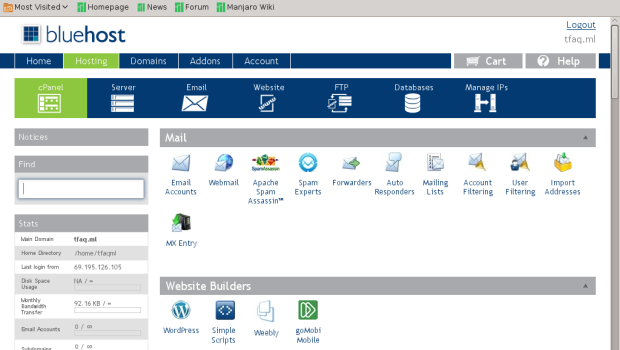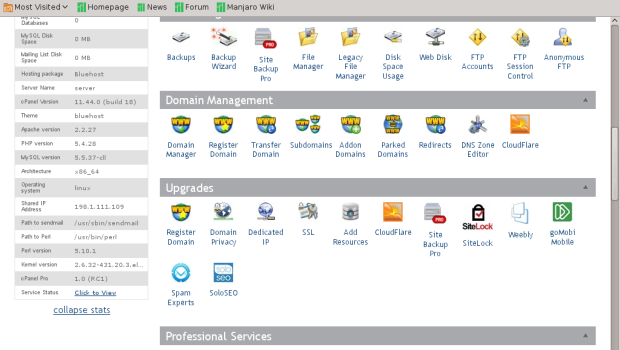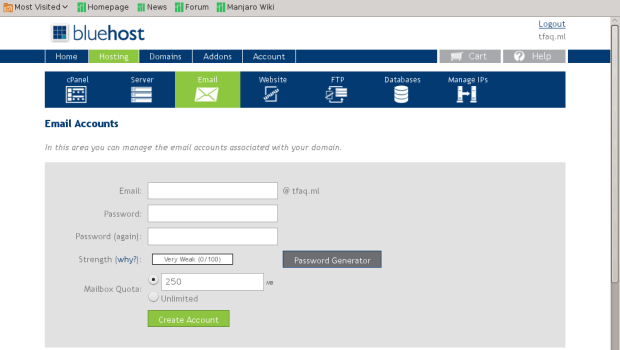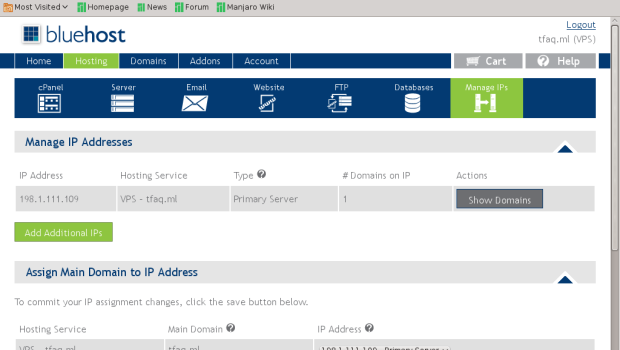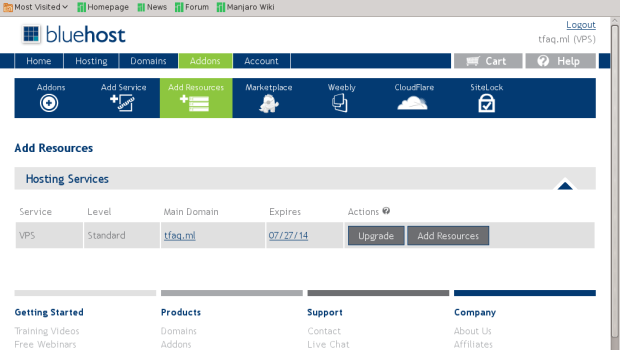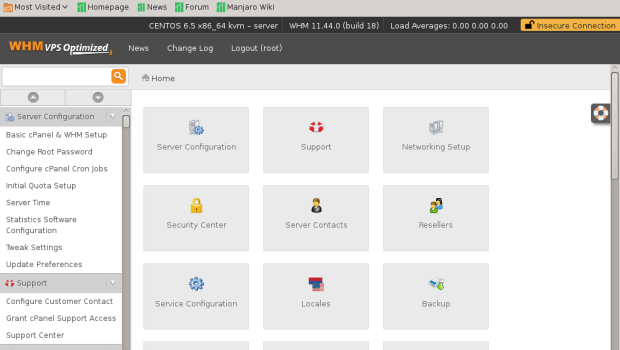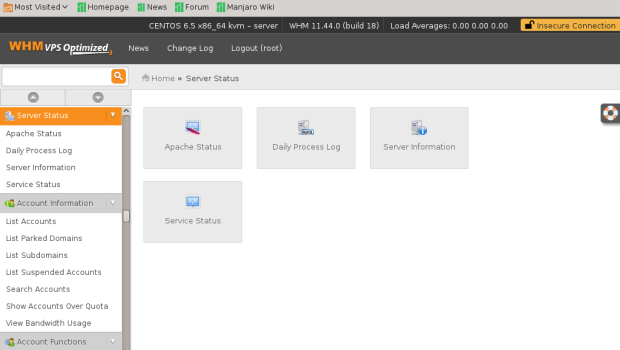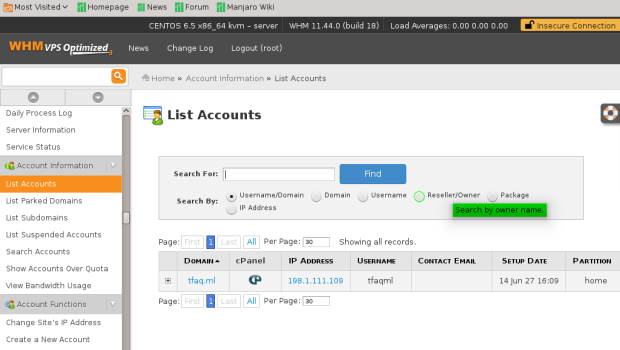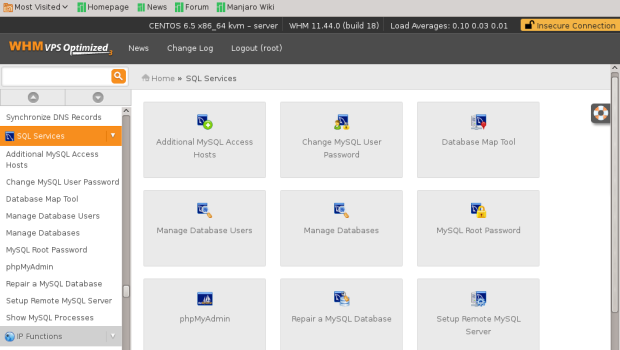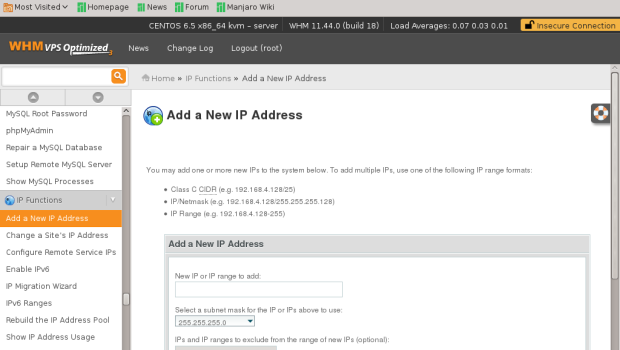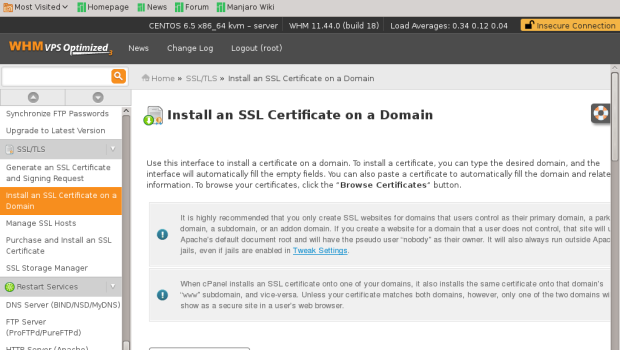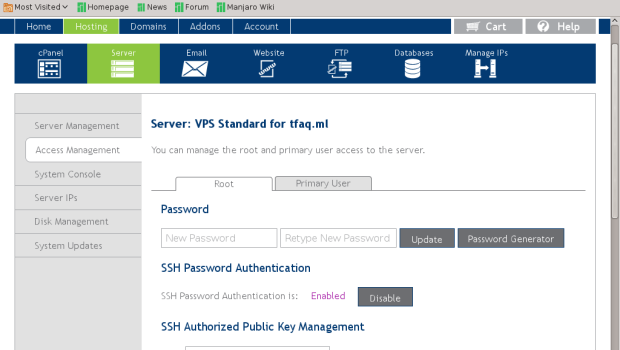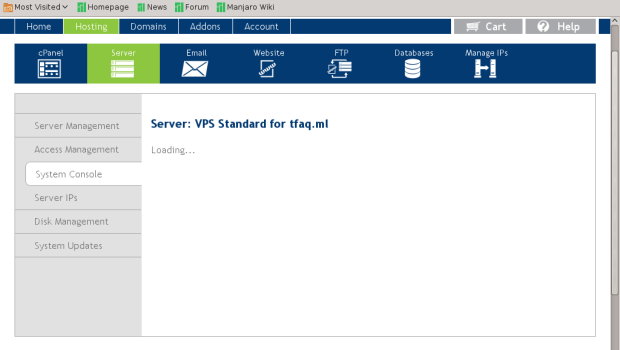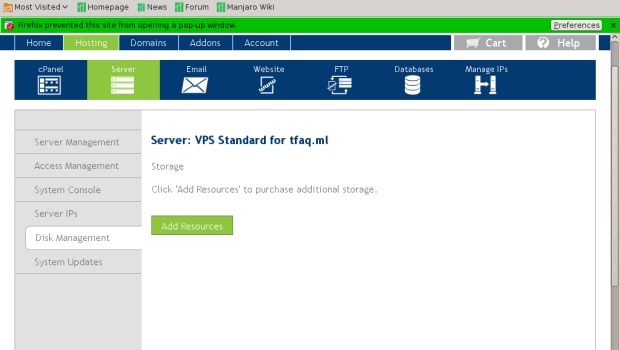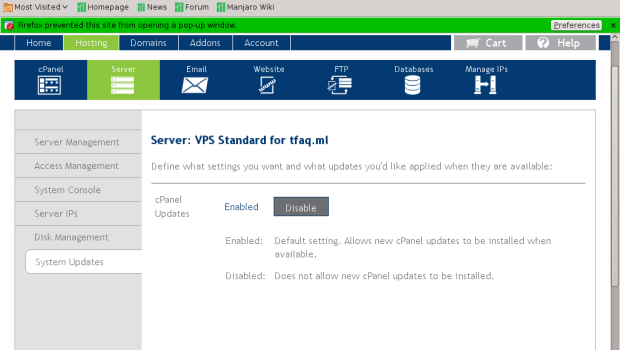BlueHost VPS review: powerful managed cPanel VPS hosting
Update on 31 October 2015: BlueHost is now offering 50% off for the first month of VPS purchases. Follow this link to grab the offer while it lasts.
One fine day, we were invited by BlueHost to try them out and write a review. I replied to them and agreed to do so. I was (naturally) expecting a shared hosting account to review. But what I got instead was an opportunity to try out their standard VPS (virtual private server) plan. I’ll try to be as detailed and accurate as possible in writing my review. So here it goes.
About the VPS plan
The plan I got to try out is the VPS standard plan. The highlights of this plan are:
- 2 CPU cores
- 2 GB RAM
- 30 GB SSD storage
- 1 TB bandwidth allowance
- 1 dedicated IP address
- a free domain name
- fully managed
- CentOS 6.5 operating system
- WebHost Manager + cPanel 11 control panel + Apache web server
All this comes at a bundled cost of US$ 29.99 per month, with the first month being charged only $14.99.
The account control panel
BlueHost uses a modified cPanel which uses a custom theme and is custom branded to the extent that is doesn’t really resemble the original cPanel. Also, it has many extensions which are directly connected to BlueHost’s other services. Long story short, the billing panel and cPanel seem to be tightly tied together.
Since this is a VPS, there is also the option of logging into WebHost Manager and changing every bit of the server settings.
BlueHost has done a wonderful job is making the panel extremely easy for new users to use, with the controls and features very easy to locate and crystal clear to understand. However, the offers/promotions that are listed as utilities/features in the panel might annoy certain people.
For VPS users there is a Server section that lets you power on/off or reboot the server, control access for users and SSH, run a VNC console and manage IP addresses, storage and system updates.
What I did notice here is that BlueHost only supports CentOS with cPanel. As of now, there is no support for other control panels or other Linux distros. BlueHost seems to be purely dedicated to cPanel/WHM hosting.
VPS performance
Since I’m reviewing a VPS, I’m not going to discuss CPU limits, MySQL connection limit or HTTP connection limit which that are usually used to judge shared hosting accounts. These parameters can be easily changed in the configuration files so it would make better sense if we judge the performance based on processor, RAM, disk and network stress tests. BlueHost states that their VPSes run on KVM and OpenStack and that their VPS nodes are hosted in the USA. First I ran the freevps.us benchmark script and the results are as follows:
[email protected] [~]# bash bench.sh CPU model : Intel(R) Xeon(R) CPU E5-2660 v2 @ 2.20GHz Number of cores : 2 CPU frequency : 2199.990 MHz Total amount of ram : 1877 MB Total amount of swap : 4095 MB System uptime : 20:54, Download speed from CacheFly: 77.9MB/s Download speed from Coloat, Atlanta GA: 944KB/s Download speed from Softlayer, Dallas, TX: 28.0MB/s Download speed from Linode, Tokyo, JP: 14.2MB/s Download speed from i3d.net, Rotterdam, NL: 2.35MB/s Download speed from Leaseweb, Haarlem, NL: 23.9MB/s Download speed from Softlayer, Singapore: 9.89MB/s Download speed from Softlayer, Seattle, WA: 37.3MB/s Download speed from Softlayer, San Jose, CA: 33.0MB/s Download speed from Softlayer, Washington, DC: 35.5MB/s I/O speed : 173 MB/s
This benchmark clearly shows that the VPS’s physical node is equipped with Gigabit ethernet. The connectivity within the USA seems to be the best (as expected) with 33 MB/sec or greater. Bandwidth is lower for connections to Asia-Pacific and is lowest for certain European locations. The random I/O speed at 173 MB/sec is quite good.
Then I ran Unixbench 5.1.3 and here is the result:
# # # # # # # ##### ###### # # #### # #
# # ## # # # # # # # ## # # # # #
# # # # # # ## ##### ##### # # # # ######
# # # # # # ## # # # # # # # # #
# # # ## # # # # # # # ## # # # #
#### # # # # # ##### ###### # # #### # #
Version 5.1.3 Based on the Byte Magazine Unix Benchmark
Multi-CPU version Version 5 revisions by Ian Smith,
Sunnyvale, CA, USA
January 13, 2011 johantheghost at yahoo period com
1 x Dhrystone 2 using register variables 1 2 3 4 5 6 7 8 9 10
1 x Double-Precision Whetstone 1 2 3 4 5 6 7 8 9 10
1 x Execl Throughput 1 2 3
1 x File Copy 1024 bufsize 2000 maxblocks 1 2 3
1 x File Copy 256 bufsize 500 maxblocks 1 2 3
1 x File Copy 4096 bufsize 8000 maxblocks 1 2 3
1 x Pipe Throughput 1 2 3 4 5 6 7 8 9 10
1 x Pipe-based Context Switching 1 2 3 4 5 6 7 8 9 10
1 x Process Creation 1 2 3
1 x System Call Overhead 1 2 3 4 5 6 7 8 9 10
1 x Shell Scripts (1 concurrent) 1 2 3
1 x Shell Scripts (8 concurrent) 1 2 3
2 x Dhrystone 2 using register variables 1 2 3 4 5 6 7 8 9 10
2 x Double-Precision Whetstone 1 2 3 4 5 6 7 8 9 10
2 x Execl Throughput 1 2 3
2 x File Copy 1024 bufsize 2000 maxblocks 1 2 3
2 x File Copy 256 bufsize 500 maxblocks 1 2 3
2 x File Copy 4096 bufsize 8000 maxblocks 1 2 3
2 x Pipe Throughput 1 2 3 4 5 6 7 8 9 10
2 x Pipe-based Context Switching 1 2 3 4 5 6 7 8 9 10
2 x Process Creation 1 2 3
2 x System Call Overhead 1 2 3 4 5 6 7 8 9 10
2 x Shell Scripts (1 concurrent) 1 2 3
2 x Shell Scripts (8 concurrent) 1 2 3
========================================================================
BYTE UNIX Benchmarks (Version 5.1.3)
System: server.tfaq.ml: GNU/Linux
OS: GNU/Linux -- 2.6.32-431.20.3.el6.x86_64 -- #1 SMP Thu Jun 19 21:14:45 UTC 2014
Machine: x86_64 (x86_64)
Language: en_US.utf8 (charmap="UTF-8", collate="UTF-8")
CPU 0: Intel(R) Xeon(R) CPU E5-2660 v2 @ 2.20GHz (4400.0 bogomips)
Hyper-Threading, x86-64, MMX, Physical Address Ext, SYSENTER/SYSEXIT, SYSCALL/SYSRET
CPU 1: Intel(R) Xeon(R) CPU E5-2660 v2 @ 2.20GHz (4400.0 bogomips)
Hyper-Threading, x86-64, MMX, Physical Address Ext, SYSENTER/SYSEXIT, SYSCALL/SYSRET
06:26:21 up 22:31, 2 users, load average: 0.00, 0.22, 1.25; runlevel 3
------------------------------------------------------------------------
Benchmark Run: Mon Jun 30 2014 06:26:21 - 06:54:38
2 CPUs in system; running 1 parallel copy of tests
Dhrystone 2 using register variables 24572182.5 lps (10.0 s, 7 samples)
Double-Precision Whetstone 2634.7 MWIPS (9.9 s, 7 samples)
Execl Throughput 2414.0 lps (29.9 s, 2 samples)
File Copy 1024 bufsize 2000 maxblocks 696914.3 KBps (30.0 s, 2 samples)
File Copy 256 bufsize 500 maxblocks 206805.9 KBps (30.0 s, 2 samples)
File Copy 4096 bufsize 8000 maxblocks 1728316.4 KBps (30.0 s, 2 samples)
Pipe Throughput 1729827.3 lps (10.0 s, 7 samples)
Pipe-based Context Switching 234688.2 lps (10.0 s, 7 samples)
Process Creation 6011.9 lps (30.0 s, 2 samples)
Shell Scripts (1 concurrent) 4745.5 lpm (60.0 s, 2 samples)
Shell Scripts (8 concurrent) 1003.9 lpm (60.0 s, 2 samples)
System Call Overhead 2962477.6 lps (10.0 s, 7 samples)
System Benchmarks Index Values BASELINE RESULT INDEX
Dhrystone 2 using register variables 116700.0 24572182.5 2105.6
Double-Precision Whetstone 55.0 2634.7 479.0
Execl Throughput 43.0 2414.0 561.4
File Copy 1024 bufsize 2000 maxblocks 3960.0 696914.3 1759.9
File Copy 256 bufsize 500 maxblocks 1655.0 206805.9 1249.6
File Copy 4096 bufsize 8000 maxblocks 5800.0 1728316.4 2979.9
Pipe Throughput 12440.0 1729827.3 1390.5
Pipe-based Context Switching 4000.0 234688.2 586.7
Process Creation 126.0 6011.9 477.1
Shell Scripts (1 concurrent) 42.4 4745.5 1119.2
Shell Scripts (8 concurrent) 6.0 1003.9 1673.1
System Call Overhead 15000.0 2962477.6 1975.0
========
System Benchmarks Index Score 1149.9
------------------------------------------------------------------------
Benchmark Run: Mon Jun 30 2014 06:54:38 - 07:22:55
2 CPUs in system; running 2 parallel copies of tests
Dhrystone 2 using register variables 49064797.8 lps (10.0 s, 7 samples)
Double-Precision Whetstone 5264.3 MWIPS (9.9 s, 7 samples)
Execl Throughput 5854.2 lps (29.7 s, 2 samples)
File Copy 1024 bufsize 2000 maxblocks 634133.7 KBps (30.0 s, 2 samples)
File Copy 256 bufsize 500 maxblocks 191697.2 KBps (30.0 s, 2 samples)
File Copy 4096 bufsize 8000 maxblocks 1897590.1 KBps (30.0 s, 2 samples)
Pipe Throughput 3292180.2 lps (10.0 s, 7 samples)
Pipe-based Context Switching 432931.5 lps (10.0 s, 7 samples)
Process Creation 12853.5 lps (30.0 s, 2 samples)
Shell Scripts (1 concurrent) 7515.8 lpm (60.0 s, 2 samples)
Shell Scripts (8 concurrent) 998.5 lpm (60.1 s, 2 samples)
System Call Overhead 3971360.5 lps (10.0 s, 7 samples)
System Benchmarks Index Values BASELINE RESULT INDEX
Dhrystone 2 using register variables 116700.0 49064797.8 4204.4
Double-Precision Whetstone 55.0 5264.3 957.1
Execl Throughput 43.0 5854.2 1361.5
File Copy 1024 bufsize 2000 maxblocks 3960.0 634133.7 1601.3
File Copy 256 bufsize 500 maxblocks 1655.0 191697.2 1158.3
File Copy 4096 bufsize 8000 maxblocks 5800.0 1897590.1 3271.7
Pipe Throughput 12440.0 3292180.2 2646.4
Pipe-based Context Switching 4000.0 432931.5 1082.3
Process Creation 126.0 12853.5 1020.1
Shell Scripts (1 concurrent) 42.4 7515.8 1772.6
Shell Scripts (8 concurrent) 6.0 998.5 1664.2
System Call Overhead 15000.0 3971360.5 2647.6
========
System Benchmarks Index Score 1737.8
This benchmark score is pretty good for a KVM based VPS with these specifications. The scores are quite close to a Intel Core2Duo or Core i3 based dedicated server.
Then I performed several ioping tests to check disk response.
First of all, disk latency:
[email protected] [~]# ioping . -c 10 4.0 KiB from . (ext4 /dev/vda1): request=1 time=143 us 4.0 KiB from . (ext4 /dev/vda1): request=2 time=254 us 4.0 KiB from . (ext4 /dev/vda1): request=3 time=192 us 4.0 KiB from . (ext4 /dev/vda1): request=4 time=199 us 4.0 KiB from . (ext4 /dev/vda1): request=5 time=282 us 4.0 KiB from . (ext4 /dev/vda1): request=6 time=447 us 4.0 KiB from . (ext4 /dev/vda1): request=7 time=205 us 4.0 KiB from . (ext4 /dev/vda1): request=8 time=191 us 4.0 KiB from . (ext4 /dev/vda1): request=9 time=212 us 4.0 KiB from . (ext4 /dev/vda1): request=10 time=282 us --- . (ext4 /dev/vda1) ioping statistics --- 10 requests completed in 9.0 s, 4.2 k iops, 16.2 MiB/s min/avg/max/mdev = 143 us / 240 us / 447 us / 80 us
I/O seek rate:
[email protected] [~]# ioping -RD . --- . (ext4 /dev/vda1) ioping statistics --- 21.3 k requests completed in 3.0 s, 12.1 k iops, 47.2 MiB/s min/avg/max/mdev = 56 us / 82 us / 1.2 ms / 35 us
Sequential I/O speed:
[email protected] [~]# ioping -RL . --- . (ext4 /dev/vda1) ioping statistics --- 8.3 k requests completed in 3.0 s, 3.1 k iops, 782.8 MiB/s min/avg/max/mdev = 242 us / 319 us / 1.1 ms / 54 us
And finally, cached I/O speed:
[email protected] [~]# ioping -RC . --- . (ext4 /dev/vda1) ioping statistics --- 2.0 M requests completed in 3.0 s, 776.9 k iops, 3.0 GiB/s min/avg/max/mdev = 0 us / 1 us / 337 us / 0 us
The disk I/O latency is pretty impressive, being in the microsecond range, which means it is either SSD or SSD-cached storage. This means that transactional services like MySQL or PostgreSQL will be running lightning fast. The sequential I/O speed at 782.8 MB/s is superb as well.
Overall the VPS has a very good and well-balanced performance and is at par with DigitalOcean and is definitely faster than Linode.
Website performance
So far we’ve been dealing with system benchmarks. In the real world, however, most benchmarks hold no strong ground. So I decided to do a small page load test.
In this test, I made copies of this Techno FAQ blog containing selected posts and deployed them: one on the BlueHost VPS and the other on my current host x10Hosting. I used Pingdom to test both the sites from the Dallas, Texas, USA location.
First, the result of the test for x10Hosting:
Then, the result for BlueHost VPS:
Click on an image to see the full page test results on Pingdom.
The results are rather ironical, being a neck-to-neck tie. Repeated further tests have shown no significant difference in load time between the two. One would usually expect the BlueHost VPS to be a little faster here considering the x10Hosting account is a shared hosting account. However, without any tweaking with the server configurations, the VPS is only as fast as a good shared host. I’d also like to add that x10 runs LiteSpeed web server while the vanilla BlueHost VPS installation comes with Apache. Had there been Nginx as an alternate web server or an accelerator on the VPS, the results would have been vastly different.
Long story short, in order to get the most performance out of the VPS, you either need to tweak the HTTP configuration and set up an accelerator (like Nginx, Squid or Varnish) or ask the BlueHost support to do it for you. The default configuration is nothing really noteworthy in terms of performance.
Customer support
BlueHost offers three support methods, namely, phone support, live chat and support tickets. Live chat is (obviously) instantaneous and you can get most problems sorted out easily with that. You may have to wait 5-10 minutes in case all the support personnel are engaged. For more critical issues, you may need to submit a support ticket. I’ve noticed that replies to tickets have taken anywhere between 1 minute to one day. I cannot comment anything about phone support as I have never used it.
I have found the support to be quite friendly and helpful. No doubts about that. Their response time to tickets are really good, but not the ridiculously fast “fanatical support” that certain other web hosts provide, like replying in under 10 minutes no matter what time of the day it is.
Additionally BlueHost has a knowledgebase, video tutorials, start wizards and a forum so that you can sort out common problems yourself.
Pricing
BlueHost offers 4 VPS plans namely:
- Standard: 2 cores, 2GB RAM, 30GB storage, 1TB bandwidth, 1 IP address at $29.99/month ($14.99 for first month)
- Enhanced: 2 cores, 4GB RAM, 60GB storage, 2TB bandwidth, 2 IP address at $59.99/month ($29.99 for first month)
- Premium: 3 cores, 6GB RAM, 120GB storage, 3TB bandwidth, 2 IP address at $89.99/month ($44.99 for first month)
- Utimate: 4 cores, 8GB RAM, 240GB storage, 4TB bandwidth, 2 IP address at $119.99/month ($59.99 for first month)
All of them come with full management, CentOS and cPanel/WHM control panel. Also, BlueHost offers a free domain registration or transfer with a VPS purchase. The plans come with an anytime money back guarantee, which means if you are dissatisfied with the service being offered, you can cancel your service anytime and receive a refund for the remaining time period. If you cancel within the first month, you get a full refund.
These prices are cheaper compared to most other managed or semi-managed VPS hosts who usually price their entry-level VPSes (with a control panel of course) at $50 or more with rather poorer specs. Here BlueHost clearly eats up rest of the competition by providing great performance at quite low prices.
Summary
The entire review can be summarized to the following points.
Pros
- Fully managed VPS with cPanel + Webhost manager + Apache web server, hence user friendly for newbies.
- Easy to use integrated hosting panel.
- Superb network performance.
- Really good computing performance.
- Insanely tiny disk latency and very good disk transfer rates.
- Reasonably good customer support via live chat.
- Awesome pricing with anytime money back guarantee.
Cons
- Only one option of OS and control panel, i.e, CentOS + cPanel/WHM.
- Default VPS configuration is not that impressive. Needs tweaking for better performance.
- Support ticket responses could have been a bit faster.
- The promotional services cluttering the hosting panel may annoy certain users.
Conclusion
If you are looking for a good fully managed VPS with easy to use cPanel control panel and great performance for a cheap price, you can give BlueHost a try. You’ll have absolutely no problems using it even if you are not a power user or you have no knowledge on administering servers. The control panels are set up in such a way it works and feels like ordinary shared hosting, with the exception having more resources and more control options. Power users can tweak the server configuration using the WebHost Manager control panel or by editing config files via shell access. Moreover, you can ask the BlueHost staff to install and manage things for you as and when needed.
Please keep in mind that the VPS service they offer is not exactly suited for developers. They are more suited for sysadmins and those who have outgrown shared hosting, and those who prefer stability and management over more OS choices and extra options. If you can live with just CentOS and cPanel, then BlueHost VPS is just for you. The performance you get is well worth the price.




